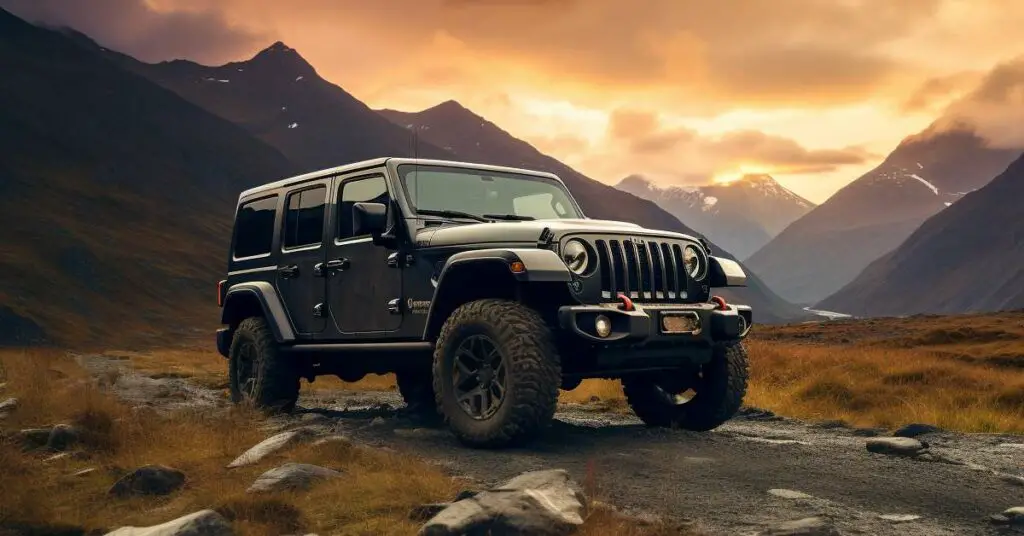
Hey, off-road adventurers and Jeep enthusiasts! Today, we’re diving into a question that’s often on the minds of potential Jeep Wrangler owners: How much is gas for a Jeep Wrangler per month? While the thought of cruising through rugged terrains in a Wrangler is exhilarating, it’s essential to consider the cost of fuel. Various factors, such as the type of engine you opt for, your driving habits, and even where you live, can significantly affect how much you’ll be shelling out at the pump.
Quick Snapshot:
- Focus: Cost of gas for a Jeep Wrangler per month.
- Influencing Factors: Engine type, driving habits, location.
- Why It Matters: Knowing fuel costs can help you budget better and make an informed buying decision.
Stay with us as we break down the fuel economy, real-world examples, and tips to get the most miles for your money.
What is Miles Per Pound (MPP)?
So, you’ve probably heard of MPG (Miles Per Gallon), but let’s kick things off by decoding another acronym: MPP, or Miles Per Pound. This metric gives you an idea of how many miles your Jeep Wrangler can cover for every pound of fuel it consumes. Handy, right? Especially when you’re trying to compare it with other vehicles in its class.
MPP Showdown: Petrol vs Diesel
| Engine Type | MPP Range |
|---|---|
| Petrol Engines | 3.6 – 4.0 MPP |
| Diesel Engines | 3.8 – 3.9 MPP |
As you can see, both petrol and diesel engines are pretty neck-and-neck when it comes to MPP. If you’re leaning towards a diesel Wrangler, you’re looking at a range of 3.8 to 3.9 MPP. For petrol engines, it’s 3.6 to 4.0 MPP.
Takeaway Points:
- Diesel engines offer a slightly narrower but comparable MPP range to petrol engines.
- Petrol engines tend to have a broader range, offering potentially higher MPP at the upper end.
Understanding MPP can help you get a clearer picture of long-term fuel costs. Keep this metric in mind as you scroll down to explore the various aspects of Jeep Wrangler’s fuel economy and running costs.
Fuel Economy in Different Wrangler Models
Alright, let’s shift gears and talk about fuel economy. If you’re eyeing a Jeep Wrangler, it’s crucial to understand that not all models are created equal—especially when it comes to MPG (Miles Per Gallon).
Wrangler Models and Their MPGs
Here’s a quick rundown of the MPG figures for different types of Wranglers:
| Wrangler Model | Fuel Economy (MPG) |
|---|---|
| Wrangler Diesel | 31.8 MPG |
| Wrangler Unlimited Diesel | 30.9 MPG |
| Wrangler Rubicon Diesel | 31.8 MPG |
| Wrangler Unlimited Rubicon Diesel | 29.7 MPG |
| Wrangler Petrol | 26.2 MPG |
| Wrangler Unlimited Petrol | 25.2 MPG |
| Wrangler Rubicon Petrol | 24.4 MPG |
| Wrangler Unlimited Rubicon Petrol | 23.3 MPG |
Food for Thought:
- Diesel Models: Generally, diesel options offer the best fuel economy. But, hang on! They’re not available anymore, at least until a plug-in hybrid model arrives outside America.
- Petrol Models: These are your go-to options right now, and they’re not too shabby either.
While no Wrangler will win a fuel-efficiency contest, for the size and shape of the vehicle, they’re quite efficient. Don’t expect miraculous numbers, but high 20s MPG is achievable if you don’t gun it through every green light.
Cost of Running a Jeep Wrangler
Time to talk numbers. We’ve covered the theoretical aspects of fuel efficiency, so let’s move on to the practical side—what does it really cost to run a Jeep Wrangler?
Average Monthly Gas Costs: By the Book
According to Fuel Economy, the average Jeep Wrangler gets about 17 miles per gallon. With the average price of gas being around $2.60 per gallon, you’re looking at approximately $148 per month. However, these numbers are just a ballpark estimate and can vary based on your driving habits and local gas prices.
Real-World Examples: Forum Insights
Let’s see what actual Jeep owners have to say. Here are some monthly gas cost estimates from Wrangler owners:
| Username | Monthly Gas Cost | Driving Habits |
|---|---|---|
| redskinswin | $200 | Daily commute, 42 miles round trip |
| robdizzle | $240 | Shuttling kids to sports |
| Drmad7 | $350 | Daily driver, 10 miles round trip |
| jkjeeper06 | $200-$500 | Seasonal activities like boating and skiing |
| KittyPrawn | $300 | Rush hour traffic, work travel |
Quick Hits:
- Driving Less: If you only drive your Wrangler on weekends and average about 100 miles per week, expect around $38 monthly.
- Daily Driver: If your Wrangler is your daily ride and you average 300 miles per week, think more along the lines of $113 monthly.
- Gas Prices: Always a wildcard. One user noted that gas hitting $4.20 threw his budget off course.
Fuel costs can swing widely based on how you use your Wrangler. Whether it’s a weekend warrior or a daily workhorse, you’ll need to budget accordingly.
Factors Affecting Fuel Costs
You’ve got the numbers, but let’s face it—life isn’t lived by the book. Many variables can throw your fuel budget out of whack or maybe even give you some unexpected savings. So, what are these elusive factors?
The Role of Gas Prices
It’s no secret that gas prices can be as unpredictable as a game of Mario Kart. One day you’re cruising along with affordable fuel, and the next, you’re hit by the proverbial blue shell of price hikes. For instance, Mark from our real-world examples noted that a spike to $4.20 per gallon messed up his budget.
The Impact of Driving Habits and Frequency
| Driving Habit | Impact on Fuel Costs |
|---|---|
| City Driving | Increases Costs |
| Highway Driving | Reduces Costs |
| Heavy Loads | Increases Costs |
| Gentle Driving | Reduces Costs |
Your driving habits can also play a huge role. City driving with frequent stops and starts can be a fuel guzzler. On the flip side, steady highway driving can be more economical. Weight is another factor; the more you haul, the more you pay.
Seasonal Activities
Some Wrangler owners noticed that their fuel expenses vary by the season. Activities like boating or skiing could lead to higher gas expenditures during certain months.
Key Takeaways:
- Gas Price Fluctuations: Always keep an eye on the gas prices and try to fill up when costs are low.
- Driving Habits: Your driving style can significantly influence your fuel costs. Lighter foot, lighter bill.
- Seasonal Expenses: Plan for higher costs during months with heavy driving due to activities or trips.
Understanding these factors can help you anticipate your monthly fuel costs better. Keep them in mind, and you won’t be caught off guard.
CO2 Emissions and Environmental Impact
Switching gears a bit, let’s talk about the environmental footprint of a Jeep Wrangler. We’ve focused a lot on costs, but what about CO2 emissions? It’s a key factor, especially for those concerned about their ecological impact.
CO2 Emissions: By the Numbers
Here’s a snapshot of the CO2 emissions range for various Wrangler models:
| Wrangler Model | CO2 Emissions (g/km) |
|---|---|
| Two-door Sahara | 195 g/km |
| Four-door Rubicon | 209 g/km |
| Two-door 2.0L Petrol | 243 g/km |
| Four-door Unlimited Rubicon | 272 g/km |
The Bigger Picture:
- High Emissions: All Wrangler models emit high levels of CO2 compared to most family cars.
- Engine Choice: The type of engine you choose will affect your CO2 emissions.
The Future: Plug-in Hybrid
The good news? Jeep is planning to offer a plug-in hybrid model, which could significantly lower CO2 emissions. Until then, you’re looking at higher-than-average emissions if you go with a Jeep Wrangler.
Key Takeaways:
- Eco-Friendly Options: Currently limited but keep an eye out for future hybrid models.
- Personal Choices: If reducing your carbon footprint is vital, you might want to explore other vehicle options until the hybrid model arrives.
Wranglers are not exactly eco-champions, but they offer unparalleled off-road capabilities. If you’re mindful of the environment, this is something to consider when making your purchase decision.
Tips for Saving on Fuel
Alright, we’ve covered a lot of ground, but let’s cap it off with some actionable tips to help you save on fuel. Because, hey, who doesn’t like to keep some extra cash in their pocket?
When to Fill Up
- Low Traffic Hours: Less idling means less fuel wasted.
- Cooler Temperatures: Believe it or not, you get more fuel when it’s cool because liquids are denser at lower temperatures.
Driving Techniques
- Smooth Driving: Avoid quick starts and sudden stops.
- Gear Shifting: If you have a manual, shifting at lower RPMs can save fuel.
- Speed Limit: Keeping it within the speed limit is not just legal; it’s also economical.
Vehicle Maintenance
- Tire Pressure: Keeping your tires inflated to the right pressure can improve mileage.
- Clean Air Filters: A clogged air filter can reduce your fuel efficiency.
- Regular Check-ups: Routine maintenance can catch issues before they become fuel-wasting problems.
Key Takeaways:
- Timing: Choose the right time to fill up.
- Technique: Drive smooth, save cash.
- Maintenance: Keep your Jeep in tip-top shape to maximize efficiency.
By following these tips, you can significantly improve your Wrangler’s fuel efficiency and make those visits to the pump a little less painful.
Frequently Asked Questions (FAQ)
As we approach the finish line, let’s tackle some of the most commonly asked questions about the fuel costs of owning a Jeep Wrangler. These quick hits can serve as a refresher or answer questions you didn’t even know you had!
1. What is the average gas mileage for a Jeep Wrangler?
The average gas mileage can vary between models, but generally, you’re looking at about 21 to 31.8 MPG, depending on whether you go with a petrol or diesel engine.
2. How much does it cost to fill up a Jeep Wrangler?
The cost to fill up can depend on gas prices and the size of your tank but expect to shell out around $60 for a full tank.
3. How often do I need to fill up?
Given an average tank size of 18.5 gallons and an average MPG of 21, you’ll need to fill up about every 382 miles. Your mileage may vary based on driving habits and the specific model.
4. Are there ways to improve fuel efficiency?
Absolutely! Smooth driving, regular maintenance, and even the time of day you fill up can contribute to better fuel efficiency.
5. What are the long-term fuel costs?
Long-term costs can vary widely based on how you use your Wrangler and fluctuating gas prices. Budgeting anywhere from $100 to $350 per month for gas would be a reasonable estimate based on user reports.
Quick Hits:
- Average MPG: 21-31.8
- Fill-Up Cost: ~$60
- Improving Efficiency: Yes, it’s possible.
- Long-Term Costs: Vary, but plan for $100-$350 monthly.

As a seasoned mechanic and proud owner of three successful car workshops, I’ve dedicated my life to helping people just like you overcome their everyday automotive challenges. I created this website as a labor of love, with a simple mission: to make car maintenance and repairs more accessible and approachable for the “average joe.”
